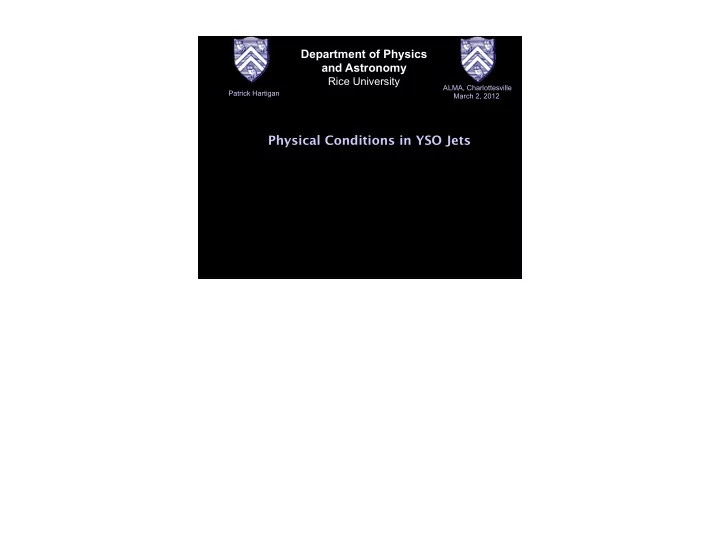

Department of Physics and Astronomy Rice University ALMA, Charlottesville Patrick Hartigan March 2, 2012 Physical Conditions in YSO Jets
OVERVIEW (Focus on atomic lines) I. Radiative Shocks II. Electron Densities, Temperatures, Ionization Fractions III. Proper Motions, Velocity Structure IV. Collimation, Opening Angles V. Magnetic Fields VI. Internal Dynamics
I. Cooling Zones Behind A Radiative Shock Dopita 1978 ApJS 37, 111 Layer of Collisionally Excited H Raymond 1979 ApJS 39, 1
II. Density, Temperature, Ionization Fraction What to do with the observed line ratios? 1 2 S 0 P 1/2 3/2 7331 2 5577 7321 D 3/2 1 5/2 D 2 6300 6363 3727 3729 3 P 0 4 1 S 3/2 2 O I (1s 2 2s 2 2p 4 ) O II (1s 2 2s 2 2p 3 ) C I, N II, O III, Ne III, Ar III N I, S II, Ne IV, Ar IV
II. Many Lines, Te and Ne 1956 ApJ 123 379
II. Many Lines, Te, Ne Brugel, Bohm and Mannery 1981 No single density or temperature describes HH objects Filling factor is low
II. Many Lines, Range of Te, Ne, X Hartigan, Morse and Raymond 1994, ApJ 436, 125 Fit a single shock model to the observed line ratios integrated over a section of the jet Find: V s ~ 25 – 40 km/s << V jet , so must have multiple bows, Dopita 1976! Mass Loss Rate: = MV/L; M=emitting mass, V=velocity, L=length use luminosity to get M in beam [problems: gas that does not emit; L to M conversion requires T e , N e , abundances; need dereddened luminosities] … or = ρ VA = (m H N e /X H )VA, A=area, N e =electron density, X H = H ionization fraction [problems: single N e , X H , what is A for a real jet (not a cylinder)?, what is ‘average’ density in a clumpy shocked flow – some average of preshock and postshock?] Find <X H > SII ~ 0.03 M-dot ~ 3x10 –7 M O yr –1 B field hard to get from line ratios, but dramatically affects compression
II. A Few Lines, Single Te, Ne, X at each spatial point Solve for (T e ,N e ,X H ) at each point in the jet from line ratios Charge exchange ties X N = NII/NI and X O = OII/OI to X H Bacciotti and Eisloffel 1999, A&A 342, 717 Decline of X H with distance X H = 0.025 – 0.25, depending on jet M-dot = ρ VA, Same problem, clumpy flows Nisini et al 2005 A&A 441, 159 (also Podio et al 2006 ) use more lines, find scatter of T e (8K – 20K), N e (10 3 – 10 5 cm –3 ) like BBM81 Moral: Single N e ,T e ,X H model works best when cooling zones resolved
II. Multiple Lines, Single Te, Ne, X at each spatial point Hartigan & Morse 2007 ApJ 660, 426
II. Physical Conditions Throughout the Jet
III. Proper Motions, Velocity Structure Linewidths > 100 km/s Suggest Bow Shocks Schwartz 1978 ApJ 223, 884 Initial Bow Shock Models Account for Large Linewidths Hartmann & Raymond 1984, Ap J 276, 560 Hartigan, Raymond, Hartmann 1987, ApJ 316, 323 Raga & Bohm 1986, ApJ 308, 829
III. Bow Shock/Mach Disk Structures Reipurth & Heathcote Hartigan 1989 ApJ 339, 987 1992 A&A 257, 693 [SII] - H α Morse et al 1992, ApJ 399, 231
III. Errors in HST Proper Motions Small Compared to Differential Motions Space Velocities in the HH111 Jet … and differential motions agree with shock models Hartigan et al 2001
III. Close to the Source: Position/Velocity Diagrams Hirth, Mundt, & Solf 1994, A&A 285, 929 (CW Tau) Connection to Disk Wind/X-wind Models Cabrit, Ferreira, & Raga 1999, A&A 343, 61 Shang, Shu, & Glassgold 1998, ApJ 493, L91 Need to know how & where jet is heated Pyo et al 2003, ApJ 590, 340 [Fe II] 1.64 µ m of DG Tau
III. Close to the source: Slit Mapping, Image Slicers Jet is fastest along the axis Lavalley et al 1997, A&A 327, 671 … and may even be rotating Coffey et al 2004, ApJ 604, 758 Woitas et al. 2005 A&A 432, 149
III. Density and Velocity Structure Near Source Velocity Structure on Density Structure on 10 AU Scales [Keck AO; RW Aur] 10 AU Scales [HST; HH 30] (Hartigan & Hillenbrand 2009 ApJ [Fe II] 1.64µm Spatial = 0.06” (8.4 AU) Velocity res= 20 km/s Note: blueshifted twice as fast as redshifted VLT: H 2 usually on sides but sometimes in jet But ratio of FWHM to velocity is the same for both (Davis et al 2011, A&A 528, A3)
IV. Jet Collimation Reipurth et al. 1986 Hartigan & Morse 2007; HH 30
V. Magnetic Fields The fact that there are shocks limits B (Hartigan et al. 2007 ApJ) Use observed compression: weak preshock B amplifies in cooling zone (Morse et al 1992) Radio continuum polarization (Ray et al 1997; Carrasco-Gonzalez et al 2010) Morse et al. 1992, ApJ 399, 233 Fairly easy to measure compression Several spatially-resolved emission Ray et al 1997 Nature 385, 415 B = several G lines and ratios give V shock Carrasco-Gonzalez et al. 2010, Science 330, 1209 B=0.2mG à Together give B ~ 30 µ G in front of bow shock
VI. Dynamics
Recommend
More recommend